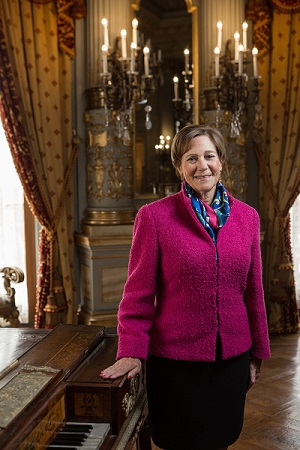Trudy Coxe is the CEO and executive director of The Preservation Society of Newport County. The society recently unveiled the restoration of a historical footpath on the grounds of The Breakers. The 1,500-foot serpentine path originally joined The Breakers to two adjoining properties and featured a connection to the sea. The portion on the Breakers property has now been replanted and restored.
Coxe spoke to the Providence Business News about efforts to revive the historical landscape feature.
PBN: Why is it important from a historical preservation standpoint to restore this landscape?
COXE: It’s important because it does reflect the path that was there when the Breakers was built in the 1890s. What is unique about this serpentine path, is it was much larger once. It connected to two adjacent properties. One is a Salve Regina [University] property. Another is a house that is no longer there but owned by Salve. But the paths that were on those two properties have disappeared over the past 100-plus years. Our path, the serpentine path, never disappeared but was not maintained in the way it could have been. There were just other priorities.
PBN: How did you resurrect this path?
COXE: We hired one of the country’s foremost landscape historians, Judith Robinson, who did phenomenal research about the Breakers landscape over the past 100 years. Over the years, this landscape has grown and grown and grown. She gave us an indication of what the original landscape architect intended. His name was Ernest Bowditch. He was working in the same period as [Frederick Law] Olmsted. We learned a lot about Ernest Bowditch and his intentions for that path.
PBN: What was his intention? That this be a wild path to the sea?
COXE: He created several, I would call them secret rooms. It ambled along the perimeter of the property. So that if you were a visitor to the Vanderbilt household, you would have a wonderful stroll and have magnificent views of the Atlantic Ocean, and wonderful blue gardens along the way, with a white garden along the way. He managed to change the feel as you were walking along.
PBN: When would this have been laid out?
COXE: Bowditch worked in the 1870s and 1880s for the previous owners of the property. He then was brought back. The original Breakers burned down in 1892. Everything was lost. [Cornelius Vanderbilt II] brought Bowditch back after the architect finished the new Breakers, to help with the landscaping.
PBN: Did any of the original plantings survive? Are they still there?
COXE: There are trees that are original. None of the plantings. One of the things that was a dilemma for us, in terms of making decisions about the landscape, is we were able to learn a little about his original flower planting scheme. Many of the flowers he planned for the 1890s would no longer grow because in the interim, the last 100 years, huge trees have grown. Those were [full sun] flowers. Now there’s shade. The only way you could have gone back to the original, is you would have had to take the trees down, and that is something we would never want to do.
Mary MacDonald is a PBN contributing writer.













